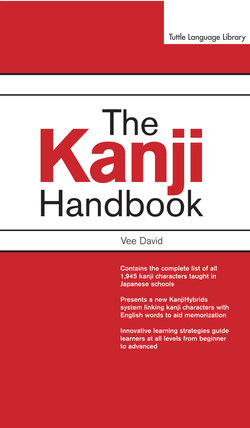Читать книгу Kanji Handbook - Vee David - Страница 9
На сайте Литреса книга снята с продажи.
ОглавлениеAcknowledgement
First and foremost, I wish to express my sincerest thanks to the people at Takahashi Educational Institution for their overwhelming support towards the publication of this book. The Institution serves as a beacon of hope for striving researchers burning the candles of the night. Without their generosity, this book would not have seen the light of day. Let me also extend my gratitude to my superiors at the Kyushu University of Health and Welfare, Miyazaki, Japan; especially to Chancellor Miyako Kake for her guidance and leadership. Helpful advice from Dr. Norimasa Mori and Dr. Yōichi Minamijima kept me focused in times of missteps and disarray. Second, I wish to extend gratitude to the entire staff of Tuttle Publishing and Periplus Editions, for taking a decisive initiative in adopting this book project for world-wide distribution.
My deepest gratitude goes out to Katsuo Nishiura, a gentle soul whom I met in my second year living in Miyazaki, Japan. As a retired principal of six junior high schools, Mr. Nishiura's curriculum vitae reads like a page of a literature book. His expertise in the Japanese and English languages proved indispensable to the successful completion of this book. With painstaking efforts, he reviewed over 35,000 word compounds—word for word, letter by letter—including the Romaji spellings and word meanings on more than 2,000 draft pages. Sifting through the pages of this book, the Kanji Handbook, I can feel his reassuring presence. I cannot say enough to thank him for all the help he devoted to a helpless friend. I am indebted to him in ways he will never know, and a lot more than I can admit.
Ialso wish to thank my faithful wife, Yuko Hirota, and my lovely daughters, Jurisa and Sara, for their encouragement and inspiration. My wife's incessant questions as to whether I could still do better—page after page—could only have come from the famed Japanese spirit. Part of the draft was written on frequent flights to New York City to be home with my girls on extended visits. In their eyes, I see the glow of the future. To my student Nao Itō for dutifully checking the brush strokes of 1,945 Kanji characters that required microscopic focus: please accept my profound appreciation. To the following librarians Kiyomi Yamaguchi, Masako Tazume, and Hitomi Iwase: I wish to give overdue credit for their skilled compilation of previous drafts. I wish to extend my appreciation to Yūji Kumamaru of the Foreign Ministry of Japan; to Paul and Betty Muller of East Sussex, England; to Ricky Rondina, Marc Trombino, Mary Duzant, Jill Caruso and Daryl Duzant of Staten Island; to the memory of my friend, Jun'ichi Taniguchi, for transforming software programming into human form; to Nobuyo Hasegawa, Yuichi Kamimura, Takahiro Kamizaki, Tōru Moriyama, Mitsutaka Sasada and Dr. Kensuke Kiyomizu; and to my over-all English editor, Katie Berkedal of La Crosse, Wisconsin. Her meticulous attention to detail, combined with sophisticated writing skills, gave the book a new breath of life in the dying days until manuscript submission. I acknowledge my eternal debt to the Great Jack Halpern, whose piercing critique led to timely revisions. This book lives on the path of his previous works, particularly on Kanji core meanings. I wish to recognize the contribution of Wilfrido Villacorta, my college guru at the De La Salle University. On a visit to Miyazaki, Japan, in September 1993, I showed him the abstract concepts of what became this book. He immediately urged me to develop them into concrete form. Over the long years from conceptual framework to manuscript completion, there were times I nearly gave up; only to find myself back on my laptop. I was answering to an inner force that I could neither contend with, nor explain. I take full responsibility for both the form and contents. I apologize for imperfections, accepting the harshest blame which is mine alone. Finally, I wish to pay tribute to my loving parents, who gave so much to get so little; for putting their best years in the worst of times—never knowing the nights from the days of life in the tempest.
New York City
16 September 2006
